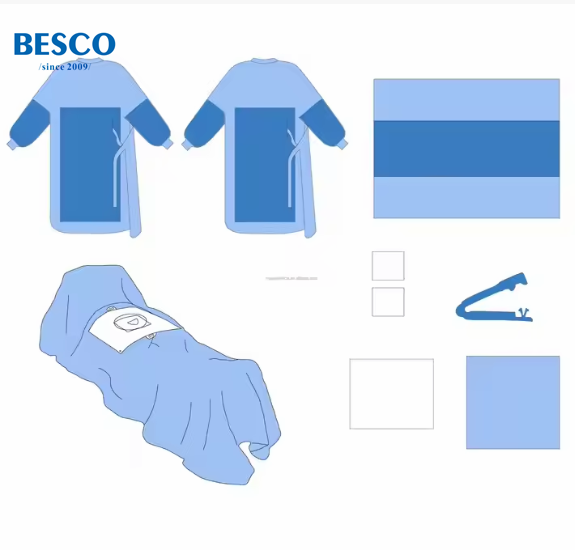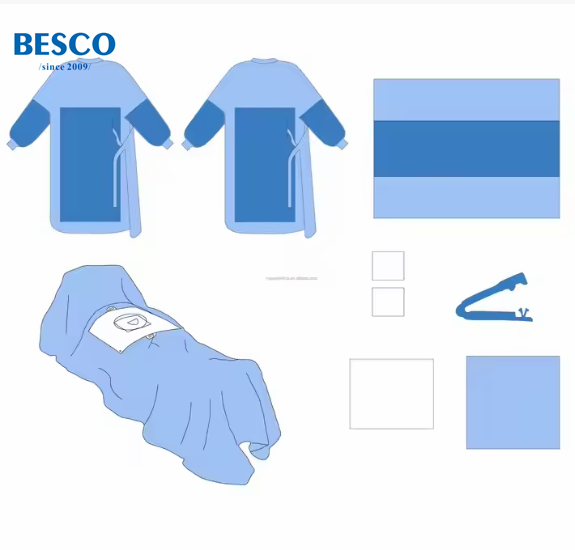Surgical Packs Developments in Central and South American Countries

Developments in South American(Argentina, Bolivia, Brazil, Chile, Colombia, Ecuador, Guyana, Paraguay, Peru, Suriname, Uruguay, and Venezuela) surgical packs are driven by increased adoption of minimally invasive surgery, leading to demand for customized, advanced packs for procedures like laparoscopy and endoscopy. The growth of ambulatory surgical centers (ASCs) in countries such as Brazil and Argentina is also increasing the need for ready-to-use, pre-sterilized packs for efficiency. Market growth is also fueled by a rising number of surgical procedures, driven by factors like aging populations, increasing chronic diseases, and greater healthcare investments and awareness of infection control, particularly in Brazil. There's also a growing trend towards sustainable and eco-friendly solutions for packaging.
Key Driving Forces:
Minimally Invasive Surgery (MIS):
.The rise of MIS, including laparoscopic and endoscopic procedures, is shifting demand towards specialized, compact, and highly sterile surgical packs.
Ambulatory Surgical Centers (ASCs):
.The establishment of ASCs in countries like Brazil and Argentina is increasing the demand for convenient, pre-sterilized, and ready-to-use packs.
Increasing Surgical Procedures:
.A higher volume of surgeries, driven by factors like chronic diseases and an expanding middle class, directly fuels the demand for surgical packs.
Healthcare Infrastructure & Investment:
.Growing investments in healthcare infrastructure and expanding medical facilities across Latin America contribute to the demand for surgical devices and packs.
Sustainability:
.Leading manufacturers are increasingly focusing on sustainable and eco-friendly packaging solutions to align with global environmental standards.
Technological Advancement:
.The adoption of digital technologies and e-commerce platforms are also contributing to market growth and efficiency in the region.
Market Trends:
Customization:
There is a growing preference for customized packs tailored to specific surgical procedures, offering convenience and cost-effectiveness.
Specialization:
As procedures become more advanced, specialized packs with fewer, more precise components are being developed.
Local Market Potential:
Brazil, with its robust domestic consumption and growing middle-class population, is a high-potential market for both local and international players.
Focus on Digitalization:
Digital technologies and the expansion of e-commerce platforms are influencing how surgical packs are distributed and accessed.

Developments in surgical packs in Central America(Belize, Costa Rica, El Salvador, Guatemala, Honduras, Nicaragua, and Panama) mirror broader trends in the regional medical device market, defined by manufacturing growth, technological advancement, and increasing demand for sterile, single-use products. However, this growth is primarily driven by export-oriented manufacturing hubs, with local healthcare systems facing challenges like diverse regulatory frameworks and supply chain complexities.
Manufacturing hubs drive development
Central America's advancements in surgical packs are concentrated in key countries that have become major manufacturing and export hubs for medical devices:
Costa Rica: The country is a leading exporter of medical devices in Latin America and has seen significant growth in its medical technology sector. It is home to numerous multinational medical technology firms, and its medical exports surpassed agricultural goods in 2017. The availability of a highly educated workforce and strategic investment have enabled the production of more technologically advanced and sophisticated surgical products.
Mexico: As a major global manufacturer and exporter of medical devices, Mexico plays a critical role in the broader Latin American market. Border proximity to the U.S. and a strong manufacturing base allow for quick supply chain turnaround times.
Key trends in surgical pack development
Specific developments related to surgical packs within the broader Central American medical device market include:
Increased adoption of sterile packs: Hospitals and surgical centers are increasingly using comprehensive, ready-to-use sterile procedure packs to improve efficiency and reduce infection risks.
Expansion in outpatient settings: Demand for more compact, procedure-specific kits is growing due to the expansion of outpatient surgery centers and ambulatory surgical units.
Move toward customization: Innovation is being driven by the ability to customize surgical packs for specific medical specialties, such as cardiology and orthopedics.
Integration of smart technology: Some advancements include the use of smart sterile packaging with RFID technology for real-time inventory tracking, expiration tracking, and improved supply chain visibility.
Eco-friendly and antimicrobial materials: Following global trends, there is an increasing shift toward sustainable and biodegradable materials for disposable packs.
AI for supply chain optimization: Hospitals and clinics are starting to use AI-powered inventory management to optimize the deployment of surgical packs.
Challenges for local adoption
Despite the region's manufacturing strength, significant challenges hinder the full, widespread adoption of advanced surgical packs in Central American healthcare facilities:
Varying regulatory landscapes: A lack of a common regulatory framework across Central American countries creates a patchwork of rules, leading to confusion and delayed market entry for new products.
Supply chain complexity: The region faces challenges related to inconsistent product availability in remote areas and inefficient supply chains, requiring manufacturers to develop strategic solutions.
Cost barriers: The high cost of disposable and advanced surgical products can be a major hurdle for healthcare providers with limited budgets.
Limited resources: Many local firms and startups lack the expertise and resources to navigate the complex compliance and oversight environment effectively.
Dependence on imports: Apart from the manufacturing hubs like Costa Rica and Mexico, many Central American countries are largely reliant on imported medical equipment, making them vulnerable to supply chain disruptions.

 Send Email
Send Email